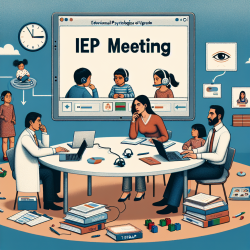Introduction
As a speech-language pathologist, understanding the multifaceted influences on a child's health is crucial. Recent research, such as the study "Examining the Influence of Built Environment on Sleep Disruption," highlights the significant role environmental factors play in sleep quality. This blog explores how practitioners can leverage these findings to improve sleep outcomes for children, thereby enhancing their overall health and development.
Key Findings from the Research
The study conducted a comprehensive evaluation of various built environment factors and their association with sleep disruption. Key findings include:
- Light-at-Night (LAN): Increased LAN exposure was linked to a higher likelihood of insufficient sleep, disrupting circadian rhythms and melatonin production.
- Greenness: Higher levels of greenness were associated with improved sleep, likely due to reduced stress and increased opportunities for physical activity.
- Air Pollution: Exposure to pollutants like sulfur dioxide (SO2) was correlated with shorter sleep durations, particularly in urban areas.
- Proximity to Roadways: Living closer to major roadways increased the odds of insufficient sleep, potentially due to noise pollution and other environmental stressors.
Implications for Practitioners
Understanding these environmental influences provides practitioners with actionable insights to enhance children's sleep quality. Here are some strategies to consider:
- Promote Greener Spaces: Encourage activities in green spaces to reduce stress and improve mental health, which can positively impact sleep.
- Manage Light Exposure: Educate families on minimizing LAN exposure, especially in children's bedrooms, to support healthy sleep patterns.
- Advocate for Pollution Reduction: Work with community leaders to address air quality issues, emphasizing the importance of reducing pollutants like SO2.
- Noise Mitigation: Suggest practical solutions for reducing noise pollution in homes near busy roadways, such as soundproofing or using white noise machines.
Encouraging Further Research
While the study provides valuable insights, it also highlights the need for further research, particularly longitudinal studies that explore the long-term effects of these environmental factors on sleep. Practitioners are encouraged to contribute to this body of research by:
- Conducting local studies to understand specific community needs and challenges.
- Collaborating with researchers to explore innovative solutions for improving sleep environments.
- Sharing findings with the broader community to advocate for policy changes that promote healthier built environments.
Conclusion
By integrating the insights from this research into practice, speech-language pathologists can play a pivotal role in enhancing children's sleep quality and overall well-being. The built environment is a modifiable factor, and with informed strategies, we can create healthier, more supportive environments for children's development.
To read the original research paper, please follow this link: Examining the influence of built environment on sleep disruption.










